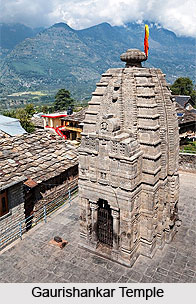 Gaurishankar Temple is one of the important religious destinations of Himachal Pradesh state of India. Consecrated to Lord Shiva and Goddess Parvati, it is an ancient stone temple located at Dashal village in Kullu district and is 8 km from Manali. It is nestled immediately below the Naggar Castle. An authentic showpiece in a serene setting, this Shaivite temple dates back to 12th century A.D. This ancient temple is a pleasant example of architecture and carving of its particular period. To add to the temple`s glory, it is considered a protected monument by the Government of India.
Gaurishankar Temple is one of the important religious destinations of Himachal Pradesh state of India. Consecrated to Lord Shiva and Goddess Parvati, it is an ancient stone temple located at Dashal village in Kullu district and is 8 km from Manali. It is nestled immediately below the Naggar Castle. An authentic showpiece in a serene setting, this Shaivite temple dates back to 12th century A.D. This ancient temple is a pleasant example of architecture and carving of its particular period. To add to the temple`s glory, it is considered a protected monument by the Government of India.
Architecture of Gaurishankar Temple
This heritage site is a must visit for its historical past and rich architecture. The temple is a fine variety of the `shikhara` style, an uncommon form of architecture in this part of the country. The sanctum sanctorum is square and dark with a linga in a yoni. In front of the Gaurishankar temple, rests an image of Nandi, the divine bull and lion-headed water spouts are carved on the temple`s exterior. The doorframe of the sanctum contains floral designs, bearing the image of Lord Ganesh. Its pillars are ornately carved with flowered scrolls alternately decked with images of Gods.
The Gaurishankar Temple is crowned with an `amalkha` on top and with `chaitya` windows decorated with floral and geometrical sculptures. The temple stands on a high podium. The entrance portrays goddesses Ganga and Yamuna on their individual `vahanas`, carrying the lance of the Mother Goddess. They are flanked by Shaivite `dwarpalas`. During night time, the Gaurishankar Temple bathed in flood lamps, offers an awe-inspiring view. The temple is embedded in the socio-religious beliefs of Pahari culture.
Attractions of Gaurishankar Temple
Shivaratri is one of the attractions of this temple. During Shivaratri, a huge fair is held here. The festival is attended by thousands of devotees to attain piousness.
Trekking in the surrounding area of the temple is another attraction. The temple is enveloped by lush and abundant greenery overlooking the sacred Beas River. The vicinity of the temple is calm and quiet which enriches one`s soul. Thus, after the trek, a visit to the temple is refreshing and rejuvenating.





















